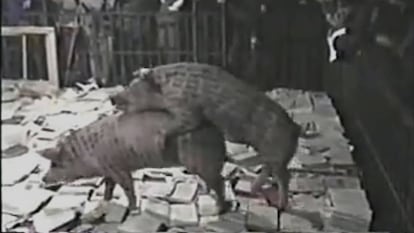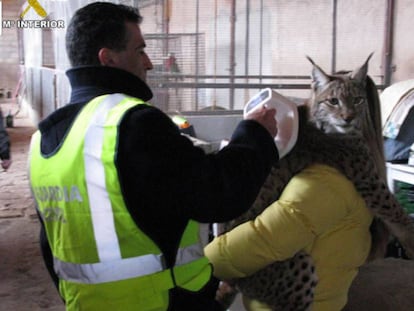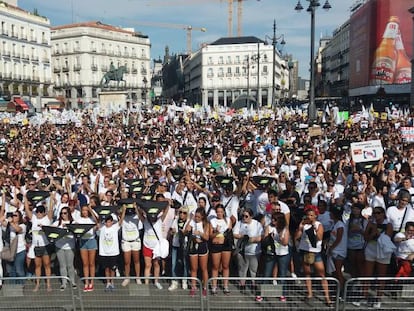Spain’s Guggenheim to show animal artworks its New York museum pulled
Controversial installations from Chinese artists include a video of two pigs copulating, as well as the use of live reptiles and insects

Beetles, cockroaches, lizards, crickets, toads, spiders, scorpions, stick insects, tortoises, snakes… Welcome to “The Theater of the World,” an installation by Chinese artist Huang Yong Ping that makes use of live specimens of these insects and reptiles. It shares a name with the exhibition it forms part of: Art and China after 1989: The Theater of the World. The show will open on May 11 at Guggenheim Bilbao, after first being shown in the New York branch of the museum.
Two statements from the artists set out their opinions in the wake of the complaints filed by animal-rights groups
“The Theater of the World” installation is made up of two cage-like structures, while a video from artist Xu Bing entitled “A Case Study of Transference” (1994) shows two pigs copulating while surrounded by members of the public. Both will be put on show at the Bilbao art gallery, in contrast to the New York Guggenheim, which “deactivated” the works in the same show, which ended in January. That’s the explanation given to EL PAÍS by Alexandra Munroe, one of the curators of the exhibition. The structures where the animals were supposed to be stood empty, while the video was turned off. Two statements from the artists were there for visitors to see, in which they set out their opinions in the wake of the complaints that were filed by a number of animal-rights associations.
The art institution cited security reasons for not showing these two works, as well as a video from artists Sun Yuan and Peng Yu, “Dogs That Cannot Touch Each Other” (2003), in which four pairs of pit bulls, who are restrained with harnesses and are on treadmills, are trying to fight each other.
“The Guggenheim regrets that violent, explicit and repeated threats have prompted us to take this decision,” the New York museum stated at the time. Groups who campaign against animal abuse had accused the museum of showing violence against animals “using art as an excuse.” They started an online petition on the platform Change.org for the Guggenheim to remove the aforementioned works, and managed to collect 600,000 signatures. The petition is still active and now has collected the support of more than 820,000 people.

The curator and the museum this week expressed their satisfaction that the works can now be seen in Bilbao. “These works are fundamental for the understanding of the moment of experimental and conceptual art that the exhibition deals with,” Munroe explained via email. “The discussion about the incorporation of live animals in the creation of artworks is important,” the expert replied to the question about the limits between the possible suffering of the animal and the incorporation of living things in works of art.
Munroe argued that in the case of the New York Guggenheim, the “indignation and the threats by activists” left no room for dialogue about these issues, and generated misunderstandings related to the works. The curator and the museum say that for this new presentation of The Theater of the World, they have worked closely with Huong Yong Ping, as well as with experts in the care of the animals that form part of the installation. “The museum has hired professionals who will supervise the state of the reptiles and insects during the exhibition’s run,” she explained.
The curator and the museum this week expressed their satisfaction that the works can now be seen in Bilbao
With regard to “A Case Study of Transference,” Munroe says that she sees no problem, given that the video was recorded in 1994. “It was conceived as a cultural allegory with a comic tone,” she explains. “The work explores the relationship between man, nature and culture. They are two pigs copulating, and one has Chinese pictograms on its skin, and the other, characters from our alphabet, in a kind of union between East and West. It’s a historical document; it doesn’t involve live pigs.” The animals, she confirms, were not tattooed with the images.
The video of the dogs has never been on the list of the works included on the Bilbao show. “The protests over this work threatened to eclipse the exhibition so we agreed with the duo of artists that we would select another of their works: ‘Freedom,’ from 2009,” the curator explains.
The Bilbao Guggenheim has defended the inclusion of the controversial works as an exercise of freedom of expression, and of respecting the artistic creative process – providing that no harm is caused to any animals, Guggenheim sources state. The museum is aware that its decision could cause a reaction among animal-rights campaigners, but insists that security controls are in place and that the animals will be properly cared for, according to the same sources.
English version by Simon Hunter.
Tu suscripción se está usando en otro dispositivo
¿Quieres añadir otro usuario a tu suscripción?
Si continúas leyendo en este dispositivo, no se podrá leer en el otro.
FlechaTu suscripción se está usando en otro dispositivo y solo puedes acceder a EL PAÍS desde un dispositivo a la vez.
Si quieres compartir tu cuenta, cambia tu suscripción a la modalidad Premium, así podrás añadir otro usuario. Cada uno accederá con su propia cuenta de email, lo que os permitirá personalizar vuestra experiencia en EL PAÍS.
¿Tienes una suscripción de empresa? Accede aquí para contratar más cuentas.
En el caso de no saber quién está usando tu cuenta, te recomendamos cambiar tu contraseña aquí.
Si decides continuar compartiendo tu cuenta, este mensaje se mostrará en tu dispositivo y en el de la otra persona que está usando tu cuenta de forma indefinida, afectando a tu experiencia de lectura. Puedes consultar aquí los términos y condiciones de la suscripción digital.
More information
Archived In
Últimas noticias
Tiger Woods turns 50: Will he continue playing on the PGA Tour or take a back seat?
The surreal journey of James Nnaji, the Barcelona youth player selected in the NBA Draft who ended up in the NCAA
Trump claims peace in Ukraine is near, but Moscow suggests otherwise
A survivor’s account of the Interoceanic Train accident: ‘We were scared because of the speed on the curve’
Most viewed
- Oona Chaplin: ‘I told James Cameron that I was living in a treehouse and starting a permaculture project with a friend’
- Reinhard Genzel, Nobel laureate in physics: ‘One-minute videos will never give you the truth’
- Why the price of coffee has skyrocketed: from Brazilian plantations to specialty coffee houses
- Pablo Escobar’s hippos: A serious environmental problem, 40 years on
- Chevy Chase, the beloved comedian who was a monster off camera: ‘Not everyone hated him, just the people who’ve worked with him’











































